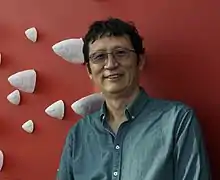Gu Xiong (artist)
Gu Xiong (born 1953) is a Canadian contemporary artist.[1][2]
Gu Xiong | |
|---|---|
 | |
| Born | 1953 (age 67–68) Chongqing, China |
| Nationality | Canadian |
| Occupation | Artist, professor |
| Known for | installation, painting, drawing, photography, performance |
| Website | Official website |
Life
Gu Xiong was born 1953 in Chongqing, Sichuan, China.[1] At the age of 18, during the Chinese cultural revolution, Xiong was sent to live in the countryside where he sketched scenes of rural life.[3] He received a Bachelor of Fine Arts and a Master of Fine Arts degree (1985)[4] from the Sichuan Fine Arts Institute.[5] In 1986, he attended an artist residency at the Banff Centre for the Arts in Alberta Canada,[6] becoming the first artist from the People's Republic of China to do so.[7] After returning to China, he was a part of the 1989 China Avant-Garde exhibition that was shut down by the Chinese police a few hours after it opened, four months before Tiananmen Square protests of 1989.[8][9][10][11] Xiong immigrated from China to Vancouver Canada in 1989.[11][12][13][14]
Xiong lives in Vancouver, where he is a professor of art at the University of British Columbia.[15][16]
Work
Xiong is a multidisciplinary artist who works in media as diverse as painting,[17] drawing,[3] photography,[18] installation, performance,[19] video[18] and bronze sculpture.[20] He is known largely for his paintings, performances and installation works. In Interior View-- Fenced Wall, performed in 1989 at the China Avant-garde exhibition in Beijing, he painted images of a fence on paper and onto his clothing and performed with his face painted in pantomime-style.[19][21][22][23] He has also done numerous similarly titled works on paper.[24][25][26]
Collections
Xiong's work is included in the permanent collection of the National Gallery of Canada,[2] the Vancouver Art Gallery,[27] the Surrey Art Gallery and the Burnaby Art Gallery.[28]
References
- "Artist/Maker Name "Gu, Xiong"". Canadian Heritage Information Network. Retrieved 12 June 2016.
- "Gu Xiong 1953 -". National Gallery of Canada.
- Griffin, Kevin (2013-07-17). "Gu Xiong: Drawing sketches during the Cultural Revolution". Vancouver Sun. Retrieved 12 June 2016.
- Michael Sullivan (1996). Art and Artists of Twentieth-century China. University of California Press. pp. 302–. ISBN 978-0-520-07556-6.
- Lyon, Christine. "Gu Xiong's global journey connects the personal with the political". North Shore News. Retrieved 12 June 2016.
- Edward L. Davis (January 2009). Encyclopedia of Contemporary Chinese Culture. Taylor & Francis. pp. 321–. ISBN 978-0-415-77716-2.
- Richard King (1 July 2010). Art in Turmoil: The Chinese Cultural Revolution, 1966-76. UBC Press. pp. 118–. ISBN 978-0-7748-5911-0.
- Paul Yee (1 December 2009). Saltwater City: Story of Vancouver's Chinese Community. Douglas and McIntyre (2013) Limited. pp. 200–. ISBN 978-1-926706-25-2.
- Scott Tyson, Ann (1989-02-07). "Avant-garde Bursts onto Chinese Art Scene. 'Action art' symbolizes artists' determination to brashly take advantage of eased state censorship". Christian Science Monitor. Retrieved 12 June 2016.
- "Blossoming of influence". The Vancouver Sun. Canada.com. Archived from the original on 22 March 2016. Retrieved 12 June 2016.
- Yishu: Journal of Contemporary Chinese Art. Art & Collection Group. 2008.
- Marie Claire Huot (2000). China's New Cultural Scene: A Handbook of Changes. Duke University Press. pp. 150–. ISBN 0-8223-2445-8.
- Gillis, Charlie. "Why China's artists are making waves, and getting away with it". Maclean's Magazine. Retrieved 12 June 2016.
- Annie Wong Art Foundation; Western Front (Society) (1998). Jiangnan: modern and contemporary art from south of the Yangzi River. Annie Wong Art Foundation. ISBN 9780968406625.
- Conner, Shawn (2001-11-24). "Q and A: Artist Gu Xiong's work born of cultural reinvention". Vancouver Sun. Retrieved 12 June 2016.
- "Professor, Xiong Gu". University of British Columbia. Archived from the original on 29 September 2015. Retrieved 12 June 2016.
- Laurence, Robin (2014-05-28). "Gu Xiong: A Journey Exposed connects the local to the global". The Georgia Straight. Retrieved 12 June 2016.
- "Gu Xiong: The Course of Globalism". Canadian Art. Missing or empty
|url=(help) - Thomas J. Berghuis (2006). Performance Art in China. Timezone 8 Limited. pp. 87–. ISBN 978-988-99265-9-5.
- Craig Pearson; Judith Nasby (11 August 2008). The Cultivated Landscape: An Exploration of Art and Agriculture. MQUP. pp. 320–. ISBN 978-0-7735-7837-1.
- Richard E. Strassberg; Pacific Asia Museum (1 January 1991). I don't want to play cards with Cézanne, and other works: selections from the Chinese New Wave and Avant-Garde art of the eighties. Pacific Asia Museum. ISBN 978-1-877921-05-6.
- China Now. Society for Anglo-Chinese Understanding. 1988.
- Wilson, Gavin. "Profile: Cultural revolutionary: Artist Gu Xiong continues the struggle for his art in Canada". University of British Columbia. Retrieved 12 June 2016.
- "Barricade of Bicycles, June 4, 1989, 1990". National Gallery of Canada. Retrieved 12 June 2016.
- "Gu Xiong Barricade of Bicycles 1989 & Cafeteria #1" (PDF). Surrey Art Gallery. Retrieved 12 June 2016.
- Günter Meißner; K.G. Saur Verlag (2009). Gryt- Guerrin. Saur. ISBN 978-3-598-23031-8.
- "Insititute of Asian Art: Collection". Vancouver Art Gallery. Retrieved 12 June 2016.
- "Collections". Burnaby Art Gallery. Retrieved 12 June 2016.